Menu
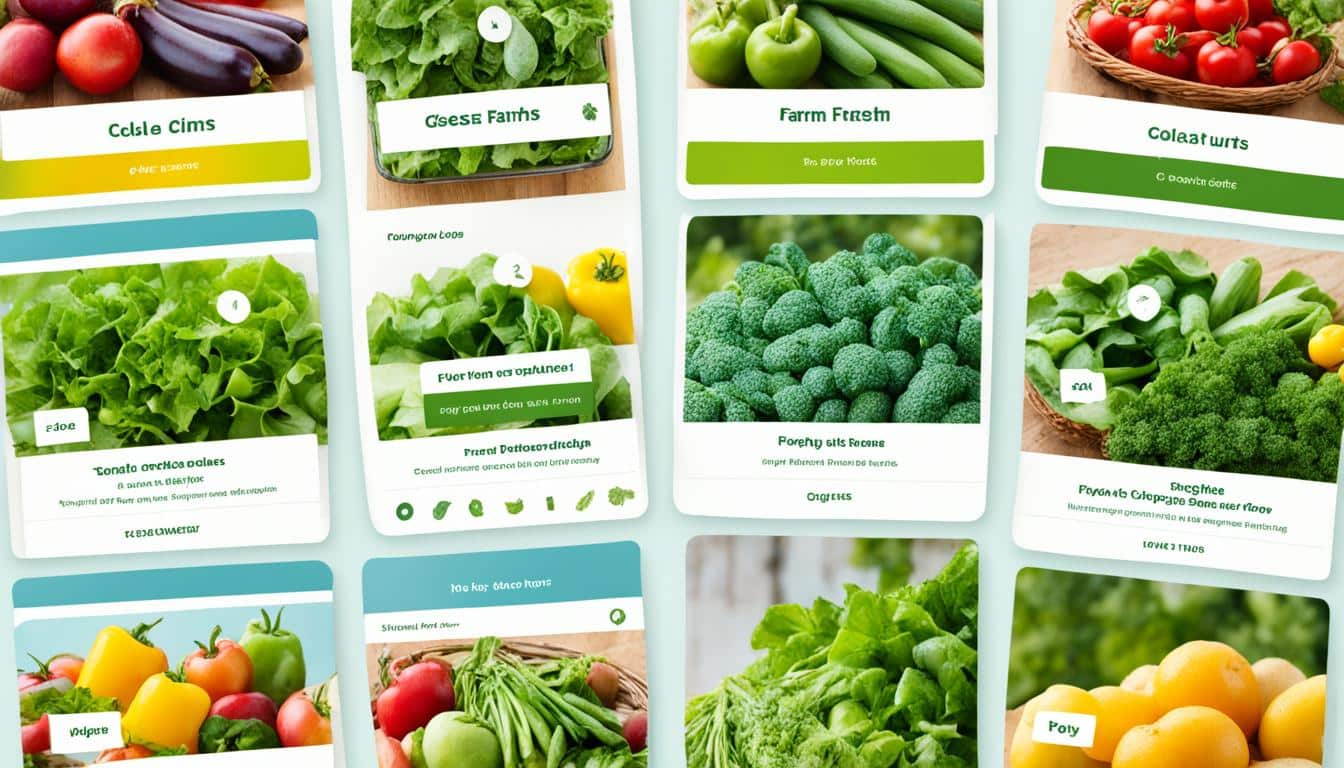
Did you know that Local Line, an e-commerce platform, is trusted by over 8,000 farms globally for their specialised e-commerce solutions?
The trend of online shopping has escalated with the pandemic. Now, people expect to buy things online, including agricultural products. For small farms and food brands, adding e-commerce to their sites is a key step.
By doing this, they can reach more customers. They can also sell a wider variety of products, like jams and cheeses, alongside their farm produce. E-commerce makes it possible for them to sell their goods all day and night.
The way we shop online has changed a lot since the pandemic. Now, farm businesses have a chance to make more money by selling their produce online. This lets farmers sell their products wider without needing a shop. They can reach more people and make more profit.
The COVID-19 outbreak caused a big increase in people shopping online. It’s a trend that keeps growing. Online marketplaces got bigger as more sellers and buyers went online. For small farms, e-commerce helps them connect with customers who might not be able to visit often.
Having an online store for farm produce means your farm is always open. Customers can see what you offer and buy any time. They get to know your products through descriptions, photos, and videos. This can lead to them buying more or different things, helping with sales.
Using e-commerce helps small farms get more customers and sell more. Buying from an online store for farm produce is easy for people who can’t visit a physical store. It opens up a new way for farms to do business.
But, it takes time and effort to set up an e-commerce site. You need to learn about its technical parts and how everything works together. It can be tough at first.
Just putting your farm products online isn’t enough to sell them well. It’s hard to connect deeply with customers without face-to-face contact. People might not feel as sure about your products. Still, learning from how customers use your website can make their shopping experience better.
Not everything can be sold online, especially products that need to be shipped. This can be tricky. But, offering different ways for customers to get their products, like delivery or pick-up, can help solve these problems.
Going online can improve how much money a farm makes. It lets farms earn more by charging fair prices for good products. But, not every farm can do this easily. Bad internet or not enough tech can be big obstacles. However, for those who can push through, the benefits are huge.
Choosing the right agricultural e-commerce solutions for a small farm e-business can feel hard. This is true especially if you lack coding skills or money for a custom website. Luckily, there are e-commerce solutions for small farms that make it easy. They offer great features and can grow with your business.
Cost is a big factor. For instance, Square’s plans range from $0 to $79/month. They also charge a transaction fee of 2.9% + $0.30 per sale. Shopify is more expensive, with prices from $29 to $299/month, but they are great for stores with more than 50 products. Shopify also charges 2.9% + $0.30 for each sale.

For farms selling meat that varies in weight, Grazecart is a good option. It has plans from $149 to $399/month. Its tools for managing inventory suit such farms well. Squarespace, priced at $27 to $49/month, is perfect for speciality food brands with fewer products. It stands out for its marketing tools, which help in managing email and digital ad campaigns.
For unique products, customisation is key. Woocommerce is a top pick. It lets you customise by creating subscriptions, bundled products, and it also offers free gift coupons. Its transaction fee is the standard 2.9% + $0.30. Woocommerce’s pricing begins at $39/month for the Essential plan.
Here is how some popular platforms compare:
| Platform | Monthly Cost | Transaction Fee | Best For |
|---|---|---|---|
| Square | $0 – $79 | 2.9% + $0.30 | Businesses with Square readers |
| Shopify | $29 – $299 | 2.9% + $0.30 | 50+ items, nationwide shipping |
| Grazecart | $149 – $399 | N/A | Meat farms, variable weight |
| Squarespace | $27 – $49 | N/A | Speciality food brands |
| Woocommerce | $39 – $129 | 2.9% + $0.30 | Customisation options |
Choosing the best e-commerce solutions for small farms means looking at costs, fees, and your farm’s specific needs. Whether you go with agricultural e-commerce solutions like Shopify for a lot of products or Squarespace for its marketing tools, each option has something special. They fit various aspects of a small farm e-business.
Small farms stepping into online sales face a big decision. The right e-commerce platform can make a huge difference. With choices like GrazeCart, Shopify, Square, and Squarespace, farmers have options that suit their unique needs. These platforms help set up online stores for farm goods.
GrazeCart shines for farms selling products like meat that vary in weight. It offers great inventory tools to make online sales easier. While it might be pricier, at $149 to $399 monthly, it’s perfect for bigger farms wanting to grow online and via wholesale. GrazeCart focuses on managing inventory and offers local delivery. This makes it a solid pick for farms looking to be more efficient and transparent.
Shopify is great for farms with lots of products and who ship nationwide. It lets farms have a lot of control over their online store’s design. At $29 to $299 a month, with extra fees on transactions, it might seem costly. However, Shopify’s tools for marketing, multiple payment methods, and mobile use are worth it. This makes it a top choice for farms looking to expand their online sales and customer reach.
Square is known for how easy it is to use, especially with QuickBooks and Square devices. It can be used for free or cost up to $79 a month and charges transaction fees. Square focuses on making sales easy on mobile devices with its tools. It also helps with inventory management and gives key sales insights. This all helps farms manage their online and offline sales efficiently and affordably.
Squarespace is all about beautiful online stores, perfect for farms with a smaller range of products. It’s priced at $27 to $49 a month, which is more budget-friendly. Despite not having many third-party connections and charging transaction fees, Squarespace offers amazing designs. It’s a great choice for farmers wanting a sophisticated and easy-to-use online look for their goods.
Choosing the right platform focuses on what your farm needs most, like good design, effective delivery, or special sales options. Each platform, whether it’s Square’s ease or Shopify’s marketing, has its own strengths. They all offer tools that help small farms succeed online, allowing them to show and sell their products effectively.
Picking the right e-commerce platform for small farms is key. Look for easy-to-use features like drag-and-drop builders. Make sure it has a good content management system (CMS) for keeping your product lists up-to-date. Also, check for strong marketing automation tools.

It’s important to know what an online store for farm produce really needs. It should be simple for people new to web design. Many platforms have easy-to-use interfaces. These let users easily set up their sites. A good CMS is also necessary. It helps show off your products accurately. You can add detailed descriptions and eye-catching photos.
Then, there’s analytics and inventory management. These are crucial for keeping track of your stock and sales. Make sure these tools work well with your other systems. Platforms like Square are great if you already use Square readers and QuickBooks. For those selling meat, consider Grazecart. It has options for variable weights and local delivery. It costs between $149 to $399 per month.
Your platform should help your farm stand out online. This means unique branding. Squarespace is good for this. It costs between $27 to $49 per month. It’s perfect for special food brands. They might have few products but want top design and marketing. For more customisation, WooCommerce is a great choice. It’s for businesses using WordPress. They can have more control over their store’s look and features.
With COVID-19, more small farms are selling online. It takes time and effort to get set up. But, the rewards are huge. You can connect more with your customers. And, you can overcome the limits of selling only in person.
When setting up your e-commerce for small farms, choose a platform that fits your needs. Look at how well it helps with stock management, marketing, and transactions. Shopify is worth considering. It’s good for managing large catalogs and shipping across the country. It costs between $29 to $299 per month.
The best e-commerce features support your farm’s goals. By choosing wisely, small farms can boost their online sales. This leads to more growth and happier customers.
Adding e-commerce to your farm site can make operations smoother and improve how users shop. It puts everything in one place for farmers. This makes running your online store easier.
Bringing e-commerce onto your farm’s website has lots of pluses. It gives customers a better experience by blending information and shopping. This makes your site a reliable spot for buying local goods.
It also helps keep your products up to date. Updates on what’s in stock can be seen straight away. So, shoppers always know what they can buy.
To add e-commerce, you can use tools that work well with your current setup. For instance, if you use Wordpress, there are plugins to help. They can make your site great for selling with features like online baskets and safe checkouts.
Services like Fresh Farm are also great. They make it easy for both you and your customers by offering simple designs. These tools help you sell better by showing off your products clearly and letting customers know more about them.
They make searching for products simple. And, they keep buying safe with good shopping baskets. This improves how people shop on your website.
Adding e-commerce to your site can also help with good food choices. It fits with the idea of buying fresh, local food that more people are into. This support is great for both local farmers and those who love their produce.
Bringing your farm items online can change your business for the better. It gives you a bigger market to sell to and can increase your sales. But, to do well in online rural retail, you need more than a basic website. You must pay close attention to how you list your products and be sure your payment system is strong.
Having a well-structured digital catalogue is key for selling your farm goods online. Use crisp, detailed descriptions and professional photos. This makes a big difference in catching and keeping customers. Also, make sure your prices are clear and you include where the products come from and any certifications. This helps build trust and make shopping a good experience:
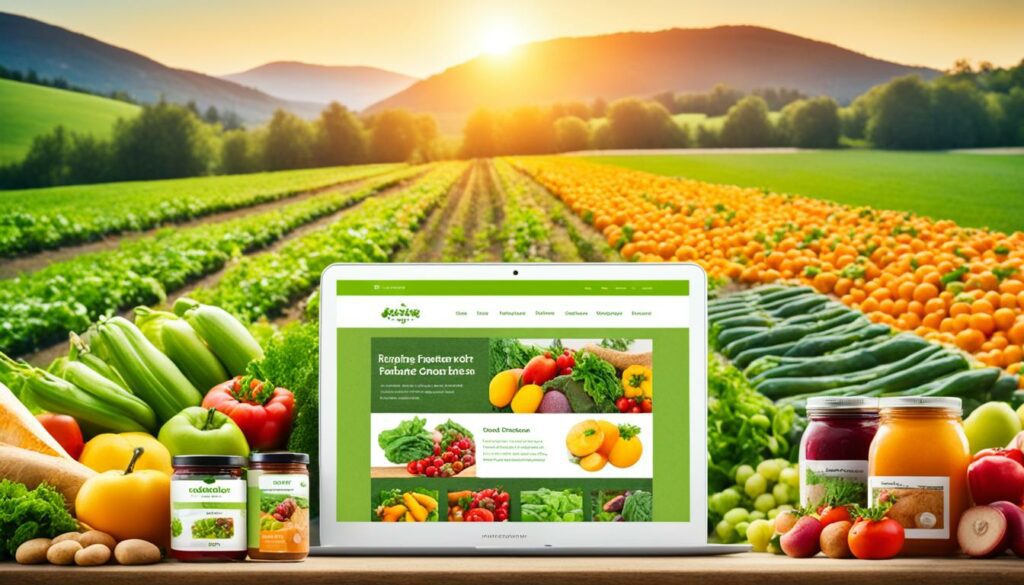
Security and ease are top priorities when adding online payments to your site. Picking a good payment system can make your sales go smoothly, affecting how much you sell. Here’s a look at some well-liked platforms:
| Platform | Monthly Cost | Transaction Fee |
|---|---|---|
| Square | $0 to $79 | 2.9% + $0.30 per transaction |
| Grazecart | $149 to $399 | – |
| Woocommerce | – | 2.9% + $0.30 per transaction |
| Shopify | $29 to $299 | 2.9% + $0.30 per transaction |
| Squarespace | $27 to $49 | – |
All these platforms aim to make paying online secure and easy for both farmers and customers.
To sell farm products successfully online, focus on how you list items and handle payments. With the right approach, small farms can do well in online rural retail, growing sales and keeping customers coming back.
Handling inventory and orders well is key for e-commerce in small farms. It ensures they meet customer needs while managing resources. Today, tools and platforms make this easier, allowing farmers to streamline online work.
Systems, like the ones from Local Line, help many farmers and food hubs worldwide. They send alerts when stock is low and offer complex management options. Farmers can set various packages, units, and prices for one product. This adaptability is key for a successful online store for farm produce.
Such systems also help organise products and manage suppliers. They aid in tracking stock, orders, prices, and deliveries. This detailed tracking is crucial for meeting customer demand accurately and avoiding overselling. With instant stock updates and reminders to restock, handling resources becomes more efficient. This leads to better online sales and happier customers.
Getting orders to customers is another vital part of farm e-commerce. There are many delivery options for different areas and customer groups. E-commerce systems can integrate these, making order handling simpler. This lowers the time and effort needed by farmers.
With effective order fulfillment, the journey from placing an order to delivery is smooth. Automated systems make sure every order is managed well. This improves customer satisfaction and helps keep a good reputation.
Linking inventory directly to sales channels benefits farms selling online. Local Line and similar platforms assist in creating detailed online inventory lists. This aids in better resource management, planning, and financial control. With advanced inventory control features, running the managing farm product inventory chores smoothly is possible.
To market your farm-to-table online shop well, you need a smart approach. This means making sure your products show up on searches. With 70% of searches happening on Google, using SEO (Search Engine Optimisation) wisely is key. This involves using the right keywords in your posts, listings, and site layout to get noticed more online.
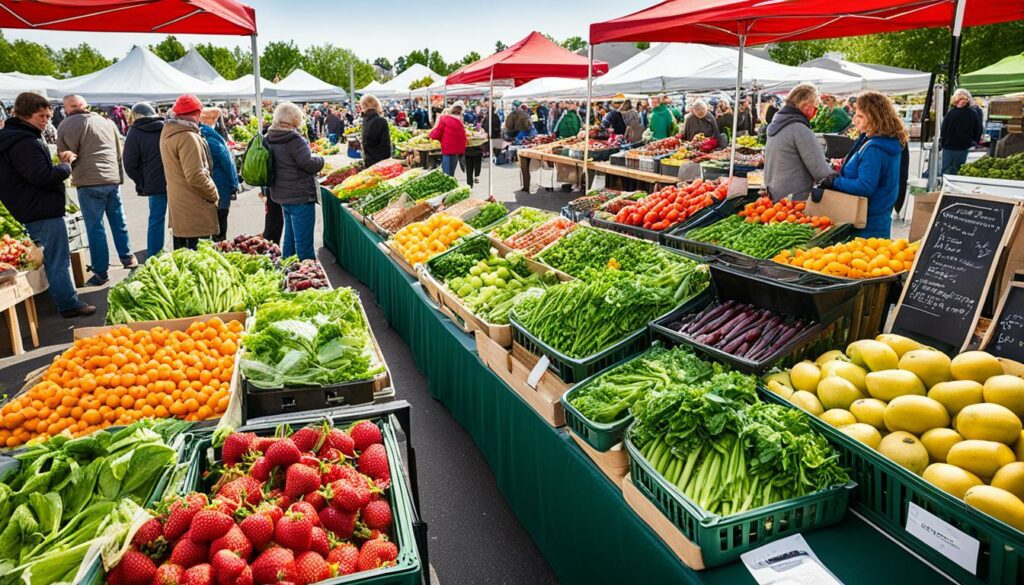
Email marketing is a great way to stay in touch with customers. You can use it to remind them about items left in their cart or to share news. Connecting it to your online shop helps you see what’s working with customers.
Social media is very important too. Sites like Facebook show what life is like on your farm and let you talk to customers. They also help attract visitors to your online shop. Don’t forget to add social media buttons to your site, making sharing simple and boosting your site’s visibility.
Using SMS for direct updates can work well, too. You can let customers know about deals or new items quickly. Also, offering loyalty benefits like discounts or first dibs on products can keep customers coming back.
Finally, having a blog can do wonders. It improves your search rankings and shows you know your stuff. Write about farm life, recipes, or stories that make customers feel connected to your brand. This kind of content helps build trust and keeps customers interested.
Making online shopping better is key for agricultural e-commerce to succeed. A smooth, fun experience keeps people coming back and buying more.
Great agricultural e-commerce solutions have a responsive design. This means the online shop is easy to use on any gadget. It makes customers happy and satisfied. Offering easy shipping, like curbside pickup, is a big hit right now. A clean, easy-to-use online shop can meet these needs well.
The PrecisionAg Alliance found that over half of farmers now shop online. Many use these websites to check out products and make purchases. This shows just how important it is for farm businesses to have top-notch online shops.
Online sales for e-commerce are growing fast – up to 900% annually. More and more, people rely on digital platforms to buy farm supplies. Services like CommoditAg, with more partners and centres, are getting better at how they help customers shop.
The aim of agricultural e-commerce solutions is to match traditional in-person shopping. By improving on what annoys customers and using new tech well, farms can make the shopping journey great. This builds lasting loyalty.
Nutrien Ag Solutions is aiming for $1 billion in online sales by the end of 2020. This goal, set since their digital platform started in 2018, shows the big promise of good agricultural e-commerce.
More and more, manufacturers and suppliers are turning to platforms like CommoditAg. They see a chance to reach more customers than before. Improving online shopping for customers opens up new chances for agricultural businesses to grow big.
In farming today, e-commerce is helping small farms reach more people and make more money. Stories from farms like Dutch Meadows and Millers Bio Farm show how going digital can boost sales and attract new customers.
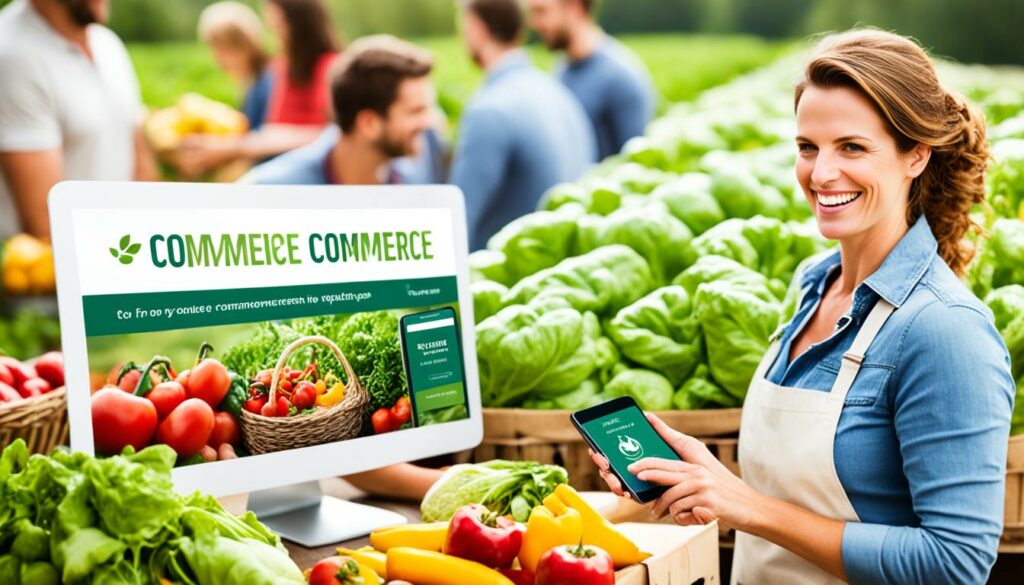
Dutch Meadows picked a perfect platform, Grazecart, for selling their meat online. This allows them to list their meat in a way that’s easy for customers to buy. They can keep track of their stock better and make more accurate deliveries. Now, they can sell to a bigger audience without as much hard work.
Millers Bio Farm is also finding success online, thanks to Shopify. They sell over 50 products, reaching customers all over the country. Using Shopify’s features for big inventories, they can meet more customer needs. This move to e-commerce has expanded their business beyond just their local farm.
Both Dutch Meadows and Millers Bio Farm show the benefits of e-commerce in farming. Their successes teach us that the right online platform can fit a farm’s unique needs. This digital move has not just improved how they work but also how they connect with more customers.
| Platform | Cost | Features |
|---|---|---|
| Square | $0-$79/month | 2.9% + $0.30 per transaction |
| Grazecart | $149-$399/month | Variable weight selling |
| Woocommerce | 2.9% + $0.30 per transaction | Customisation capabilities |
| Shopify | $29-$299/month | Large product catalog, nationwide shipping |
| Squarespace | $27-$49/month | Advanced design and marketing tools |
Managing the logistics of local deliveries is key for small farms online. This ensures farm products are delivered efficiently. It helps both the farm and its customers.
Using platforms with customisable delivery areas, cash on delivery, and routing software can make things easier. For instance, OptimoRoute helped Tomato Mountain Farm. They improved their delivery service massively. This led to more subscribers and a larger delivery team. Plus, notifications cut down on service calls by 70%.
Local Roots NYC also saw amazing growth, from 50 to over 1,000 weekly deliveries in a month, thanks to OptimoRoute. Similarly, Oco Meals’ planning time dropped by 90%. Their orders shot up by 200% after they switched from manual planning to OptimoRoute.
To manage farm deliveries well, using software that links inventory and a POS system is a must. This ensures the deliveries are well-coordinated and customers are happy. Tomato Mountain Farm found that manual scheduling had a 3% error rate. They stress the importance of using automated solutions.
Using analytics in local delivery logistics is getting more important. 96% of senior executives see analytics as key in the next three years. So, farms using data and planning tools will operate better and serve customers well.
| Platform | Cost | Transaction Fee |
|---|---|---|
| Square | $0-$79 per month | 2.9% + $0.30 per transaction |
| Grazecart | $149-$399 per month | – |
| Woocommerce | – | 2.9% + $0.30 per transaction (U.S.-issued cards) |
| Shopify | $29-$299 per month | 2.9% + $0.30 per transaction |
| Squarespace | $27-$49 per month | – |
Social media is now a key marketing tool for farms. With almost 80% of U.S. people on social media, there’s a huge audience for your farm. Customer engagement boosts sales significantly, urging farms to use platforms like Facebook and Instagram.
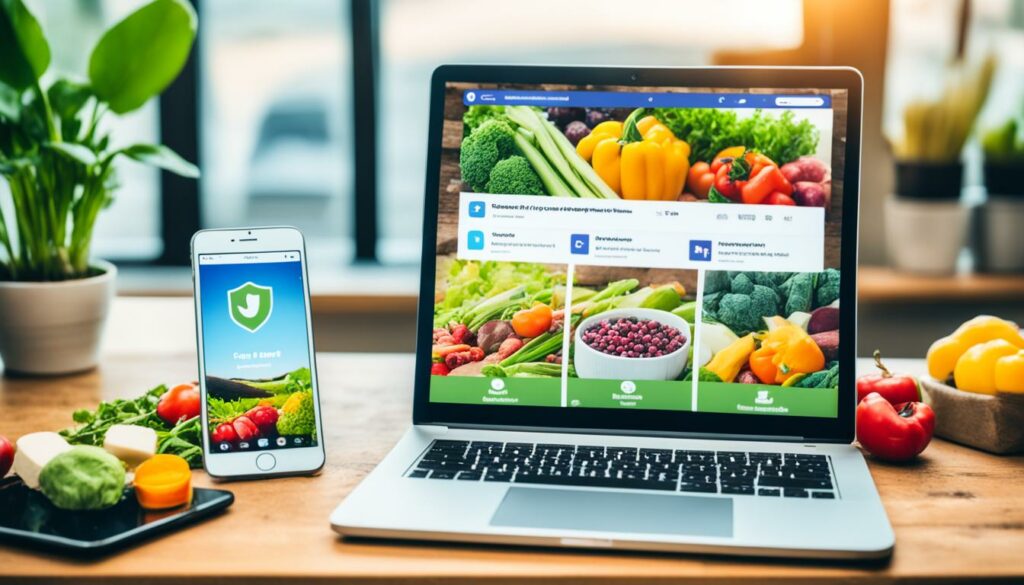
Facebook ads help farmers reach a varied age group, mostly around 40 years old. Instagram targets those aged 25-34, perfect for reaching the younger, health-focused market. Putting e-commerce on these platforms makes buying easier for everyone.
Reaching out to customers builds your online image. It takes about seven interactions for a customer to really notice a brand. For small farmers, staying in touch can turn possible buyers into loyal fans.
Platforms like Barn2Door’s Marketing Toolkit save farmers time while still reaching customers effectively. Not answering questions on social media could turn off 88% of potential buyers. Quick customer service is essential.
About a third of Americans search for local businesses online daily, with most preferring to buy local. For farmers, this shows a big chance to attract customers who value local products.
| Platform | Primary User Age | Key Features for Farmers |
|---|---|---|
| 40 years | Targeted advertising, strong engagement tools | |
| 25-34 years | Visual content strength, younger audience reach |
Using both Facebook and Instagram can increase a farm’s online presence and sales. It solidifies your place in the digital market.
Learning to use SEO well is vital for your online farm shop’s success. It helps your shop be seen by more people. Online platforms have tools to help your farm’s site do well on search engines. This is essential for finding customers looking for farm products online.
Keywords are key to good SEO. You must use words that customers might search for. For instance, including phrases like ‘SEO for farm produce sales’ can boost your site’s ranking. Adding these keywords to your product info and blog posts helps your site show up in searches. To choose the best keywords, you need to know your target audience. Using tools like Google Trends and Keyword Planner can help.
Making content that’s interesting and SEO-friendly can help your farm’s online store. Write blogs about your farm and your produce’s advantages. Make sure to include keywords like ‘maximising farm website SEO.’ Also, focus on meta descriptions and use alt text for images to help search engines find you. Organising your content with clear headings and links can improve your site’s experience for users and its search ranking.
Take a look at the table below for the main features of three popular e-commerce platforms:
| Platform | Main Features | Integration |
|---|---|---|
| Eat From Farms | Friendly technical support, handles CSAs, onsite pick-up, and home delivery | Does not integrate with QuickBooks or Mailchimp |
| Barn2Door | Email marketing, tutorials, account management | Integrated with Stripe, QuickBooks, MailChimp |
| GrazeCart | Sophisticated online sales and fulfilment, variable pricing, consumer and wholesale support | Suitable for larger farms scaling up |
To sum up, choosing the right keywords and making SEO-friendly content can improve your online farm shop a lot. The right tools and platforms, like the ones mentioned, can also help you run your online shop better.
Products like jams, jellies, and cheeses give farmers a chance to earn more and reach new customers. To sell these well, you need to know what customers want, show your products right, and stay organised with stock and orders.

Valued online farm goods include jams, cheeses, soaps, and syrups. They find success by aiming at smaller markets. Jams and jellies interest those wanting something different. Artisanal cheeses catch the attention of gourmet lovers.
A Southern US study of 14 farmers spotted ten secrets to value-added benefits. It pointed out the need for a smart plan and aiming at unique markets. They found that sales might start slow but can pick up, reaching 100 weekly orders.
Picking the right tools for selling farm products online is key. Platforms like Squarespace excel in design, making your products look great. GrazeCart works well for items that vary in stock, like cheese sold by weight.
There are rules to follow, such as needing a licensed kitchen for food products. But a good business plan can help you tackle them. Turning to places like the Food Innovation Centre can aid in making and marketing your products.
About 80% of online sales are individual items, while 20% are customisable boxes. This shows people like tailored options. Selling around 100 orders each week proves that a well-managed online shop can succeed with the right approach.
The world of farming is changing fast, thanks to digital technology. Now, small farms can look to the internet for help. They can quickly buy seeds and tools online. This means they don’t need to spend time going to stores.
Also, online shops show lots of info on different seeds. This helps farmers make the best choices for their fields.
E-commerce isn’t just about buying easier. It’s also a way for farmers to see and compare prices from different sellers online. This might help save money, which is big for small farms.
Then, there’s the chance to build long-lasting agreements with buyers. This can help both farmers and their customers. Plus, if farmers need a bit of financial help, some online shops offer loans.
Thanks to e-commerce, small farms can now sell their goods to more people. A study from parts of the US like Kansas and Missouri proved this. Farmers there saw more money and growth, thanks to using the internet.
At first, some of them were worried about the costs and other issues. But, they found that online selling really helped their business. It brought them closer to new customers and kept their prices steady.
So, as we wrap up, it’s clear that e-commerce is a game-changer for small farms. It helps them work better, save money, and reach out to new clients. This is all key for their future success and strength in the market.
Bringing e-commerce to small farms leads to more customers and higher sales. It lets farms sell all the time and keep track of their items easily. This method also makes marketing special products, like jams, easier. It improves the buying experience from farm to table.
GrazeCart is great for farms that sell meat of different weights. Shopify works well for farms with many products that they ship across the country. Square is fantastic because it links with Quickbooks. Squarespace is best for farms that focus on design and have a smaller range of products.
To pick the best platform, look at what your farm needs. Think about managing stock, delivering goods, and how easy the platform is to use. Choosing one with tools for marketing and easy website building can help your store grow and do well.
Look for platforms that are easy to use, let you design your website without code, and help you market your items. It’s good if they check your stock, track how your site does, and work well with the website you already have.
You can add e-commerce to your website through plugins on platforms like WordPress. Special services also offer to connect your website smoothly to online sales. This creates a better experience for people who visit your site.
Make sure to describe your products well, use good photos, and set the right prices. Keep your online shop tidy and make it safe and simple to pay.
Use tools that tell you when to restock. Pick shipping options that match where your customers are. This could mean local delivery or shipping across the country.
Use tools like SEO, email, and social media to tell people about your shop. Try things like automatic emails for abandoned carts or loyalty schemes to keep customers coming back.
Choose a site that works well on all devices and let’s customers pick the best way to get their items. Pick a platform that helps make shopping personal and easy. This keeps people happy and coming back.
Sure, Dutch Meadows and Millers Bio Farm are doing well. They chose platforms suited to their needs. For instance, GrazeCart was great for selling products of different weights. This helped them sell more and manage their sales better.
Local deliveries need detailed zones, options to pay when the item is delivered, and good route planning. It’s also important to keep all your pickup points stocked up and connected to your shop’s system. This way, you can make deliveries on time and keep your customers happy.
Using social media like Facebook and Instagram can help sell more online. They’re good for showing ads and keeping in touch with customers. Tools that link your shop to social media can make selling through these channels easier and bring in more sales.
SEO helps your shop come up high in search results, so more people find it. Using the right words in your content and product descriptions can draw in more visitors. Many e-commerce platforms offer tools to help your shop get noticed.
Find a good platform like Squarespace for design or GrazeCart for handling various products. These will help you show your products in the best light and ensure that shopping online with you is a good experience.